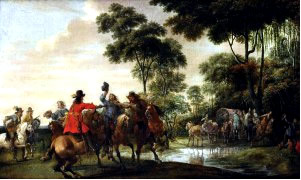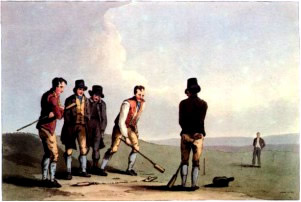Before it became a landscaped park, Leeds’s Woodhouse Moor was a wild, rough stretch of common land on the town’s North-Western fringe, scarred by disused quarries and coal-pits, bordered by mean cottages, and grazed by livestock. The baying of hunting hounds kept in kennels there could be heard, and dog and cock fights drew rude crowds. Despite the Town Council’s purchase of it in 1855, ostensibly to undertake its improvement, it could still be described in the 1860s as a “ragged moor”, and “a compound of bog and puddle” which was “ploughed up by pigs, and rutted and cut up by carts, and made a depositary for all sorts of rubbish.”
Such out-of-town moorland was traditionally regarded as dangerous terrain that travellers would pass through quickly in case highwaymen were lurking about. Riders and pedestrians alike were regularly assailed, beaten and robbed on Woodhouse Moor. And a variety of more unusual hazards abounded there, which I shall describe hereafter as reported in the local press.

“Highwaymen raiding a tilt car by a forest stream”, Peter Snayers (1592-1667) Public Domain
Unbridled violence, sometimes as a public spectacle, often took place on Woodhouse Moor. A prize fight (for one guinea) held there in 1835 caused “a great assemblage of people to collect together,” and was “attended with considerable excitement …endangering the public peace.” An 1830 dispute regarding “a certain young lady”, led two gentlemen to fight a duel with pistols on the Moor, one receiving “his adversary’s shot in his left side.” Later that year, a deaf and dumb man “passing over Woodhouse Moor…was met by some fellows who robbed him of a silver watch.” In 1833 a Leeds merchant was assaulted there by two blackened-faced ruffians armed with a stick, who, “tore off one of his breeches pockets, containing £3, with which they ran off.”
In 1829 Joshua Grant, a “well-known disorderly” of Woodhouse, having been ejected from the Red Lion pub (at what is now Hyde Park Corner) for drunkenness and threatening behaviour, chased and violently assaulted an innocent bystander on the Moor by throwing a large stone at the back of the man’s head, so that “A torrent of blood gushed from his nose and mouth and he was taken home for dead…”. His victim survived, but on the very day Grant was let loose from custody he went on to engage in “a sanguinary pugilistic contest” elsewhere. The Leeds Intelligencer remarked that “Warning and lenity, to such men, are totally fruitless.”
At the annual Woodhouse Feast, “mountebanks, clowns and rough-riders catered for the people’s amusement.” Woodhouse Races, which accompanied the feast until the mid-nineteenth century, attracted assorted villains as well as “many a motley fool.” Gambling and pocket-picking (or “conveyancing”) were rife. Several such incidents at the races held in the September of 1846 occasioned press coverage:
One “young urchin” picked a silk handkerchief from the pocket of a gentleman who was rendering assistance to a man knocked down by a horse. A woman was sent to Wakefield jail for gambling, despite her protestation that “if she’d ‘know’d’ there was a law prohibiting such work, she would have been the last woman in the wide-world to break it.” A pair of girls were committed to Wakefield for a month each for pick-pocketing. A pair of youths were committed to be tried for the same offence, though “According to their own account they were very ill-used persons, and very innocent withal.” A trio of youths was sent to the stocks for gaming, and “The exhibition of these wooden-gartered loons was a rare source of amusement …”
Other “sporting” pursuits on the Moor brought their own dangers. A twelve year old boy was accidentally shot in the forehead during a pigeon shooting match in 1836, and in 1838 a man was killed in the same way. These incidents led to the use of firearms on the Moor being banned, but this was ignored and a correspondent to the press (calling himself “Ranger”) in May 1839 noted that a practice of shooting arrows (“tipped with sharp pointed steel, and…shot from very powerful bows”) was also widespread. Pigeon shooting was still going on in May 1854, when another correspondent (named “Fairplay”) denounced it (“Dear Sir, I have the strongest possible objection to being shot…why can’t I take a walk on Woodhouse Moor without running the chance of never getting home again?”)
Even apparently benign sports could prove hazardous to the recreational stroller. The ancient game of “Knor and Spell” (or Knurr and Spell) was played on the Moor for monetary stakes, often before large crowds. This featured a small wooden ball (the knor) being thrown up from a trap and hit by a bat (the spell). Each player had so many such “rises” of the ball (usually 30), and the winner was the one who drove it the furthest aggregate distance (“score yards”).
Airborne knors endangered pedestrian safety, and so did the games of rough cricket that were all-too-prevalent on the Moor. “Only a Burgess” wrote to the Leeds Mercury in August 1861 that he had been hit on the cheek-bone, while out walking with his wife, by a cricket ball: “One side of my face is now considerably larger than the other, and I feel altogether as if my nervous system had sustained a very severe shock”. He demanded that the council prevent the playing of “dangerous games in public places”.

“Yorkshiremen playing Knurr and Spell”, from George Walker’s “The Costume of Yorkshire” (1814) Public Domain
Calls for the council to turn the Moor into a proper park appeared regularly in the press. “An Inhabitant” wrote in such terms to the Leeds Mercury in June 1864 declaring that other northern towns (especially Manchester!!!) had “handsome public parks”. He went on to bemoan “the danger to which pedestrians are exposed (notwithstanding bye-laws and police regulations) from galloping horses and flying balls.” The bye-law outlawing horse-riding was widely flouted, and in July 1863 Thomas Horncastle Marshall, a Judge of the Leeds County Court no-less, was himself convicted of this offence by the Leeds magistrates and fined the derisory sum of one shilling.
Definite proposals to transform Woodhouse Moor (“the Lungs of Leeds”) into a safe public amenity, fit for all citizens, did not receive serious consideration by the Town Council until the late 1860s. Even then, progress was slow and seems to have been piecemeal. But the work of draining and landscaping was undertaken, and by 1889 Jackson’s Guide to Leeds could describe the Moor as “a public park with some pretentions to beauty,” and remark that “The ornamentation is the gradual growth of the last dozen years.”
In 1906, the Yorkshire Evening News celebrated the “civilisation” of the Moor, a condition no-doubt gratifying to North-West Leeds’s view of itself as home to a refined and cultivated citizenry.
Sources
Newspapers:
Leeds Intelligencer 10/5/1819, 4/6/1829, 11/6/1829, 20/8/1829, 11/3/1830, 18/3/1830, 30/12/1830, 20/7/1833, 2/4/1836, 30/6/1838, 7/7/1838, 4/5/1839, 30/9/1843, 3/10/1846, 5/8/1848, 8/5/1854, 29/9/1855, 31/10/1857, 20/2/1862; Yorkshire Evening News 28/4/1906; Leeds Times 20/7/1833; 4/2/1843; 25/3/1843, 7/10/1843; Leeds Mercury 4/4/1835, 28/7/1838, 22/8/1861, 6/7/1863, 8/6/1864, 30/7/64, 29/9/1868.
Books:
“East End, West End: The Face of Leeds during Industrialisation”, Maurice Beresford (1988); “Woodhouse Moor”, by Edna Bews in “Aspects of Leeds”, ed. L.S. Tate (1998); “Jackson’s Guide to Leeds” (1889)
